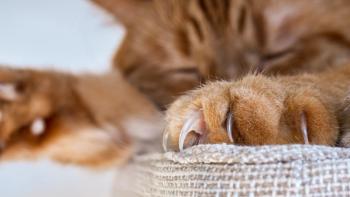
ACVC 2019: Feline onychectomy: What we know and what we dont

While the push to end the practice of onychectomy continues, much has yet to be learned about the long-term consequences of the procedure.
Dr. St. Denis addresses the audience at ACVC.More and more states are following in New York's footsteps and considering a ban on the practice of declawing, but in the interim, it's incumbent on veterinarians to explain to clients the potential effects of the procedure and to counsel on alternatives, according to a speaker at the 2019
“The long-term impacts of declawing are not well documented or understood, and there is a paucity of studies examining the long-term side effects,” Kelly A. St. Denis, MSc, DVM, DABVP (feline practice), explained to attendees. During her session, Dr. St. Denis outlined what is known and unknown about the procedure and offered client communication tips about alternatives to the procedure.
What we know
Why clients typically want to declaw-and some alternatives. Typical reasons that pet owners ask veterinarians to declaw cats include protecting furniture from cat scratches, protecting family members from cat scratches and a belief that cats may transmit diseases like Bartonella henselae to others in the households. But cats can easily be trained to
Surgical, short and long-term risks. Because the surgical techniques vary widely, Dr. St. Denis said the risks and complications also vary. She listed the following surgical short- and long-term risks:
Surgical risks
Damage to collateral tissue including paw pads, P2, nerves and blood vessels
Insufficient pain prevention and management
Potential for hemorrhage
Potential for tissue burns (on both the patient and the performer of the procedure) from laser techniques
Intraoperative tourniquet that results in reduced blood supply to the limb and nerve damage.
Short-term postoperative concerns
Hemorrhage
Infection of surgical site
Wound dehiscence
Remnants of P3 left in situ
Reactions to suture or tissue adhesive used in closing surgical sites
Remnants of tissue adhesive causing subcutaneous swelling or discomfort
Reduced blood supply with postoperative bandaging
Postoperative pain as a result of the surgery in general and/or associated with any of the above complications.
Long-term concerns
- Arthritis
- Osteomyelitis
- P3 remnants causing pain
- P3 remnant regrowth
- Tissue adhesive remnants causing pain and inflammation
- Tendon contracture?
- Chronic phantom pain/amputee pain
- Altered gait
- Chronic pain as a result of any of the above complications
- Behavior changes.
What we don't know
Neurologic, musculoskeletal and behavioral consequences
Nerves are severed during onychectomy, which means that changes in nerve firing, nerve response to stimulation and nerve health may occur, Dr. St. Denis explained.
Human medicine has shown a number of potential neurologic pain issues associated with amputation, and Dr. St. Denis said there's no arguing that in this process “we are amputating a piece of a digit.” She noted some of the human neurologic issues following amputation:
Stump pain in the residual portion of the amputated limb
Phantom pain, characterized by sensations experienced in the body part that no longer exists. This is exacerbated by stress, anxiety, exhaustion and depression.
Neuropathic pain, caused or initiated by a primary lesion or dysfunction in the peripheral or central nervous system.
Neuromas, which are benign proliferations of severed nerve fibers associated with disorganization of the nerve fibers, increased sensitivity and abnormal nerve signals.
Cats in particular are known to be masters at hiding illness, Dr. St. Denis said, which makes it difficult to document signs of pain. Some clinical signs that may occur with some of the neurologic conditions include:
Allodynia
Intermittent lameness
Holding up one or both paws
Backing away from forelimbs
Appearing sore to the touch.
Alternatives to declawing
The
As cat owners continue to turn away from declawing, veterinarians will need to be ready to offer alternatives and training advice, Dr. St. Denis said. These could include:
Offering clients regular nail trims at a discount rate
Teaching clients how to trim cats' nails themselves
Recommending Soft Paws, nail caps for cats
Educating on all appropriate resource and environmental management.
Editor's note: This article originally (and incorrectly) said that Dr. St. Denis suggested in her session that surgical tenectomy is a possible alternative to onychectomy. In fact, Dr. St. Denis only mentioned the procedure as a "treatment for tendon contraction ...[and] nobody should be practicing tenectomy as an alternative to declawing." We regret the error.
Newsletter
From exam room tips to practice management insights, get trusted veterinary news delivered straight to your inbox—subscribe to dvm360.






